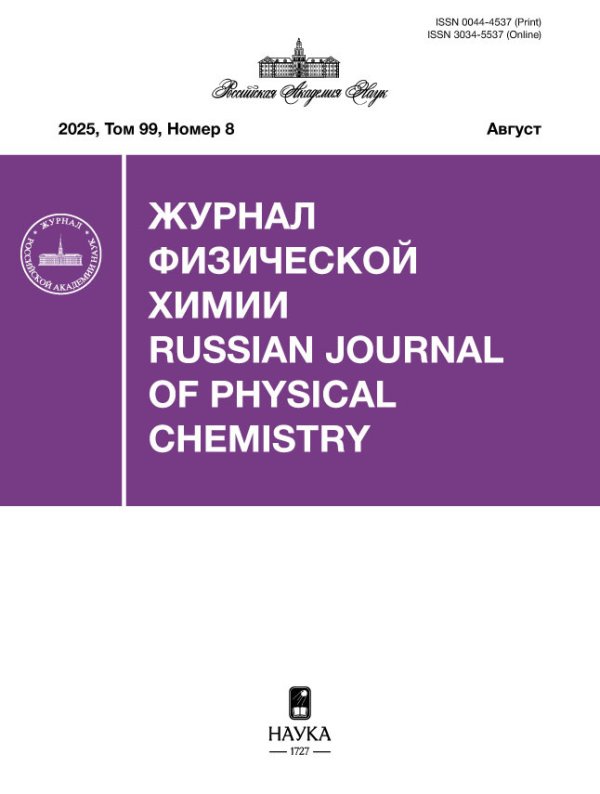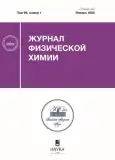On applicability of embedded atom model (EAM) potentials to liquid silicon and germanium
- Authors: Belashchenko D.K.1
-
Affiliations:
- National University of Science and Technology (MISiS)
- Issue: Vol 99, No 1 (2025)
- Pages: 122-134
- Section: ХЕМОИНФОРМАТИКА И КОМПЬЮТЕРНОЕ МОДЕЛИРОВАНИЕ
- Submitted: 01.06.2025
- Published: 17.04.2025
- URL: https://innoscience.ru/0044-4537/article/view/681875
- DOI: https://doi.org/10.31857/S0044453725010122
- EDN: https://elibrary.ru/EIAKHV
- ID: 681875
Cite item
Abstract
Potentials of the embedded atom model (EAM) for liquid silicon and germanium are proposed. The potentials are calculated from diffraction data using the Schommers algorithm and presented in the form of tables and piecewise continuous polynomials. Each pairwise contribution to the potential has a form close to a hard-sphere one with a step down. The properties of liquid Si and Ge at temperatures up to 2000 K are calculated, viz. the density, energy, bulk modulus, and self-diffusion coefficients. The agreement with the experiment is noted to be good. The bond direction is found to almost completely disappear after melting for ordinary densities of liquid Si and Ge. The bond direction is assumed to be able to appear at heating and when the density of melts is decreased by 2–3 times.
Keywords
Full Text
About the authors
D. K. Belashchenko
National University of Science and Technology (MISiS)
Author for correspondence.
Email: dkbel75@gmail.com
Russian Federation, Moscow
References
- Waseda Y. The Structure of Non-Crystalline Materials. Liquids and Amorphous Solids. N.Y.: McGraw-Hill, 1980.
- Funamori N., Tsuji K. // Phys. Rev. Lett. 2002. V. 88. P. 255508.
- Demchuk T., Bryk T., Seitsonen A.P. et al. // arXiv:2009.00834. https://doi.org/10.48550/arXiv.2009.00834
- Assael M.J., Armyra I.J., Brillo J. et al. // J. Phys. Chem. Ref. Data. 2012. V. 41. № 3. https://doi.org/10.1063/1.4729873
- Глазов В.М., Чижевская С.Н, Глаголева Н.Н. Жидкие полупроводники. М.: Наука, 1967.
- Гурвич Л.А., Вейц И.В., Медведев В.А. и др. Термодинамические свойства индивидуальных веществ. Т. 2. Кн.2. М.: Наука, 1979.
- Desai P.D. // J. Phys. Chem. Ref. Data. 1986. V. 15. № 3. P. 967.
- Текучев В.В. Акустические и физико-химические свойства электронных расплавов. Волгоград. 2016.
- Регель А.Р., Глазов В.М. Физические свойства электронных расплавов. М.: Наука, 1980.
- Weis H., Kargl F., Kolbe M. et al. // J. Phys.: Condens. Matter. 2019. V. 31. P. 455101.
- Luo Sheng-Nian, Ahrens T.J., Asimow P.D. // J. Geophys. Res. 2003. V. 108. № B9. P. 2421. https://doi.org/10.1029/2002JB002317.
- Oleynik I.I., Zybin S.V., Elert M.L., White C.T. // CP845 “Shock Compression in Condensed Matter”. Ed. M.D. Furnish et al. 2005. P. 413.
- Stillinger F.H., Weber T.A. // Phys. Rev. B. 1985. V. 31. P. 5262.
- Dziedzic J., Principi E., Rybicki J. // J. Non-Cryst. Solids. 2006. V. 352. P. 4232.
- Jadhav P.P., Dongale T.D., Vhatkar R.S. // AIP Conference Proceedings 2162, 020038 (2019). https://doi.org/10.1063/1.5130248
- Tersoff J. // Phys. Rev. B. 1988. V. 38. P. 9902; 1989. V. 39. P. 5566.
- Ishimaru M., Yoshida K., Motooka T. // Phys. Rev. B. 1996. V. 53. № 11. P. 7176.
- Cook S.J., Clancy P. // Phys. Rev. B. 1993. V. 47. P. 7686.
- Bazant M.Z., Kaxiras E. // Phys. Rev. Lett. 1996. V. 77. P. 4370.
- Luo J., Zhou Ch., Cheng Y., Liu L. // J. Crystal Growth. 2020. P. 1. https://doi.org/10.1016/j.jcrysgro.2020.125785
- Štich I., Car R., Parrinello M. // Phys. Rev. B. 1991. V. 44. P. 4262.
- NIST. IPS Interatomic Potentials Repository: www.ctcms.nist.gov/potentials/refs.html
- Baskes M.I. // Phys. Rev. B. 1992. V. 46. P. 2727. https://doi.org/10.1103/PhysRevB.46.2727
- Baskes M.I., Nelson J.S., Wright A.F. // Phys. Rev. B. Condens. Matter. 1989. V. 40. № 9. P. 6085. https://doi.org/10.1103/physrevb.40.6085
- Starikov S.V., Lopanitsyna N.Yu., Smirnova D.E., Makarov S.V. // Computational Materials Science. 2018. V. 142. P. 303.
- Starikov S., Gordeev I., Lysogorskiy Yu. et al. // Computational Materials Science. 2020. V. 184. P. 109891. https://doi.org/10.1016/j.commatsci.2020.109891
- Daw M.S., Baskes M.I. // Phys. Rev. B. 1984. V. 29. № 12. P. 6443.
- Schommers W. // Phys. Rev. A. 1983. V. 28. P. 3599.
- Belashchenko David K. Liquid Metals. From Atomistic Potentials to Properties, Shock Compression, Earth’s Core and Nanoclusters. NOVA Science Publushers. NY.
- Zhu Z.G., Liu C.S. // Phys. Rev. B. 2000. V. 61. № 14. P. 9322.
- Hayashi M., Yamada H., Nabeshima N., Nagata K. // Int. J. Thermophysics. 2007. V. 28. № 1. P. 83. https://doi.org/10.1007/s10765-007-0151-9
- Chelikowsky J.R., Troullier N., Binggeli N. // Phys. Rev. B. 1994. V. 49. P. 114.
- Yu W., Wang Z.Q., Stroud D. // Phys. Rev. B. 1996. V. 54. № 19. P. 13946.
- Белащенко Д.К // Журн. физ. химии. 2019. T. 93. № 6. C. 877.
- Speedy R.J. // Mol. Physics. 1987. V. 62. № 2. P. 509.
- Бeлaщeнкo Д.K. // Physics–uspekhi. 2013. V. 183. № 12. P. 1176.
- Alteholz Th., Hoyer W. // J. Non-Cryst. Solids. 1999. V. 250–252. P. 48.
- Petkov V., Takeda S., Waseda Y., Sugiyama K. // J. Non-Cryst. Solids. 1994. V. 168. P. 97.
- Sato Y., Nishizuka T., Tachikawa T. et al. // High Temperatures – High Pressures. 2000. V. 32. P. 253.
- Tsuchiya Y. // J. Phys. Soc. Japan. 1991. V. 60. № 1. P. 227.
- Masaki T., Itami T. // “Modeling and Precise Experiments of Diffusion Phenomena in Melts under Microgravity” Annual Reports. 2002, NASDA-TMR-030005E.
- Kato M., Minowa S. // Trans. Iron Steel Institute of Japan. 1969. V. 9. P. 39.
- Tsuji K., Mori T., Hattori T. et al. // 2000B0087-CD-np BL04B1.
- Kōga J., Okumura H., Nishio K. et al. // Phys. Rev. B. 2002. V. 66. P. 064211.
- Kishimura H., Matsumoto H., Thadhani N.N. // J. Physics: Conference Series. 2010. V. 215. Р. 012145. https://doi.org/10.1088/1742-6596/215/1/012145
- Ding K., Andersen H.C. // Phys. Rev. B. 1986. V. 34. № 10. P. 6987.
- Kim Eun Ha, Shin Young-Han, Lee Byeong-Joo // Computer Coupling of Phase Diagrams and Thermochemistry. 2008. V. 32. P. 34.
- Zuo Y., Chen C., Li X. et al. // J. Phys. Chem. A. 2019. V. 124. № 4. P. 731. https://doi.org/10.1021/acs.jpca.9b08723
- Kresse G., Hafner J. // Phys. Rev. B. 1994. V. 49. № 20. P. 14251.
- Белащенко Д.К. // Кристаллография. 1998. Т. 43. № 3. С. 400.
- Kulkarni R.V., Aulbur W.G., Stroud D. // Phys. Rev. B. 1997. V. 55. P. 6896.
- Lucas L.D., Urbain G. // C. r. Acad. Sci. 1962. V. 255. № 19. P. 2414.
- Munejiri S., Shimojo F., Hoshino K., Itami T. // NASDA, Tsukuba 305–8505, Japan
- Hoshino K. // J. Phys.: Condens. Matter. 2009. V. 21. No 47. P. 474212. https://doi.org/10.1088/0953-8984/21/47/474212
Supplementary files



















